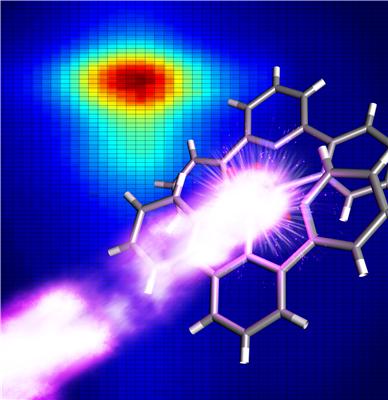Nov 9 2012
Together with a large international research team, Johannes Messinger of Umeå University in Sweden has taken another step toward an understanding of photosynthesis and developing artificial photosynthesis. With a combination of a x-ray free-electron laser and spectroscopy, the team has managed to see the electronic structure of a manganese complex, a chemical compound related to how photosynthesis splits water.
 Illustration of ultra-short x-ray pulse striking molecules containing manganese: Greg Stewart, National Accelerator Laboratory at Stanford University
Illustration of ultra-short x-ray pulse striking molecules containing manganese: Greg Stewart, National Accelerator Laboratory at Stanford University
The experiments used the Linac Coherent Light Source (LCLS), which is a free-electron x-ray laser facility at Stanford University in the US. The wavelength of the laser is roughly the same as the breadth of an atom, and each pulse of light lasts 50 femtoseconds (10-15). This is an extremely short interval of time: there are more femtoseconds in one second than there are seconds in a person’s life. Such extremely short wavelengths and short light pulses constitute ideal conditions for imaging chemical reactions with atomic resolution at room temperature while the chemical reactions are ongoing.
The research group has previously used LCLS to perform structural analyses of isolated photosynthesis complexes from plants’ photosystem II at room temperature. Now the group has combined the method with spectroscopy and is the first team to succeed in seeing at LCLS the electronic structure of a manganese complex similar to that found in photosystem II. Manganese is a transitional metal that, together with calcium and oxygen, forms the water-splitting catalyst in photosystem II.
A very simple example of a spectrometer is a prism, which separates sunlight into all the colors of the rainbow. The spectrometer used in this study functions in a similar manner, but with a group of 16 specialized crystals that diffract the x-rays emitted from the sample in resonse of being excited by an x-ray pulse onto a detector array.
To the delight of the scientists, the manganese compounds remained intact long enough for them to observe detailed information about the electronic structure before the compounds were destroyed by the very intense X-ray laser beam.
“Having both structural information and spectroscopic information means that we can much better understand how the structural changes of the whole complex and the chemical changes on the active surface of the catalysts work together to enable the enzymes to perform complex chemical reactions at room temperature,” says Johannes Messinger, professor at the Department of Chemistry at Umeå University.
The chemical reaction the research group aims to understand is the splitting of water in photosystem II, as this understanding is also key for developing artificial photosynthesis– that is, for building devices for producing hydrogen from sunlight and water. To be able to exploit sunlight for producing fuels that can be stored and the used when needed would help solve the world’s ever-more acute energy problems.
The new research findings are being published in the highly regarded journal Proceedings of the National Academy of Sciences, PNAS.
Two major research projects at Umeå University are focusing on the development of artificial photosynthesis by imitating plants’ very successful way of exploiting solar energy. Both projects (“solar fuels” and “artificial leaf”) are directed by Johannes Messinger, professor at the Department of Chemistry at Umeå University.